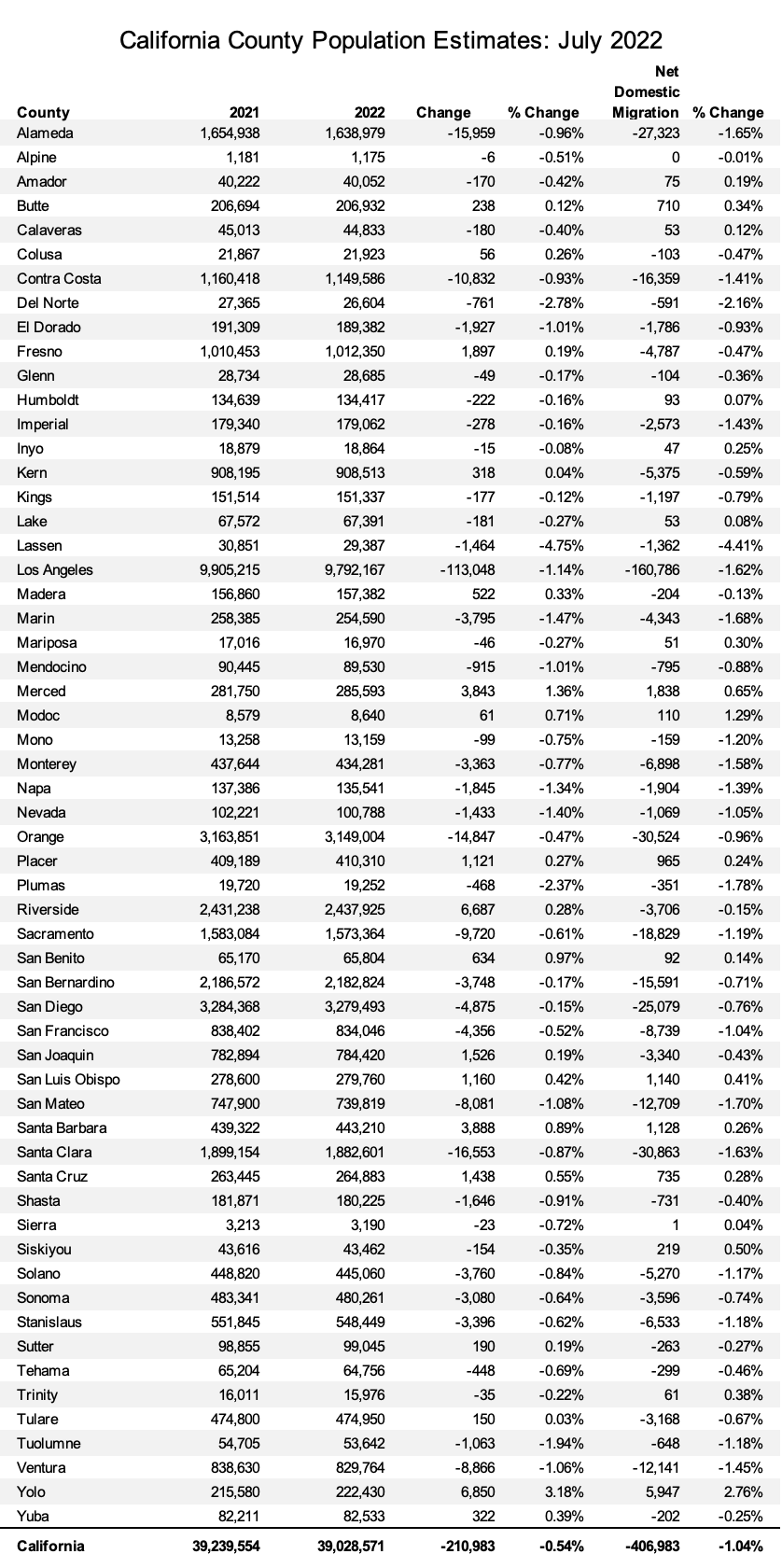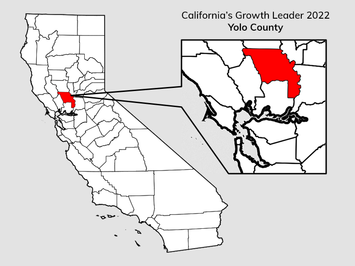
California continues to lose population, according to the latest State Department of Finance estimates for the year ended July 2022.
The state dropped from 39.2 to 39.0 million population in 2022, for a loss of 211,000 residents. This is a minus 0.54 percent annual rate. The state had natural population growth of 106,000, comprised of 424,000 births and 318,000 deaths and a net gain of 90,000 from international migration.
The key, as it has been for many years, lies in substantial net domestic migration. More than 406,000 more residents moved out than moving in from other states and the District of Columbia. This is nearly half-again as large as the 276,700 in 2021, which was the largest net domestic migration loss reported in two decades. (Figure 1).
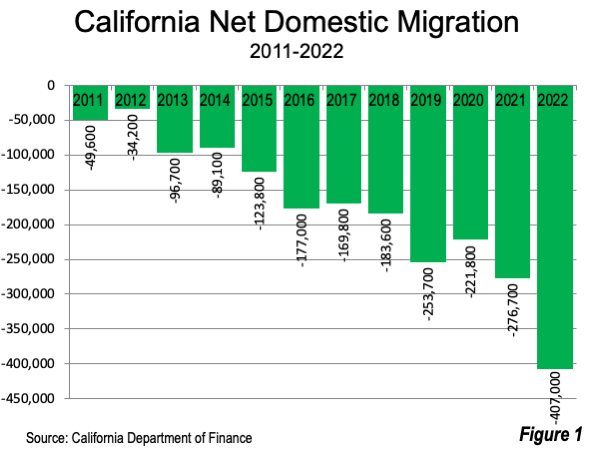
These changes are also altering the state’s geography. Among the state’s 58 counties, only 18 gained population, while 40 lost. Similarly, 18 counties added net domestic migrants, one county had zero and 57 lost domestic migrants.
Yolo County
Amazingly, the largest growth occurred in the 27th largest county, Yolo, with only 0.6% of California’s population. Yolo County is in the Sacramento metropolitan area, directly across the Sacramento River from the state capital. Yolo County gained 6,900 new residents, a stunningly low figure for the maximum population growth in a state of 39 million. But the growth rate of 3.18% was very strong, as a result of its comparatively small population (222,000). Yolo County also led the state in net domestic migration, gaining 5,900 new residents.
Yolo’s share of the population growth of the 18 counties gaining population is 22.25%, while its share of the net domestic migration in the 18 gaining counties is 44.7%. At the same time, these shares could never have been achieved but for California’s unprecedented losses (Figure 2).
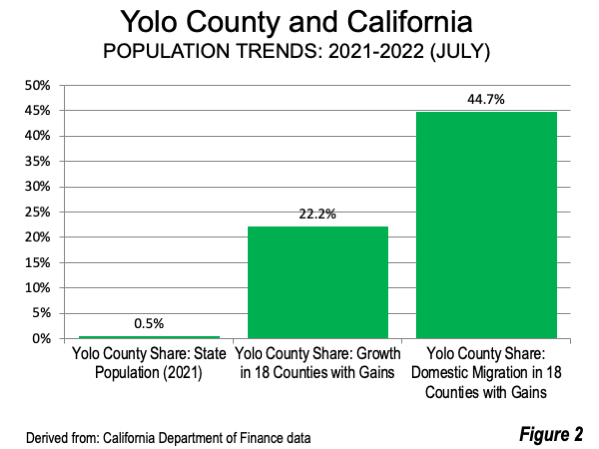
The improbable strength of the Yolo County trend in relation to the much more populous counties of the state is illustrated in Figures 3 through 5, which are maps provided by DOF. Yolo County’s location is identified in the map at the top of the article.
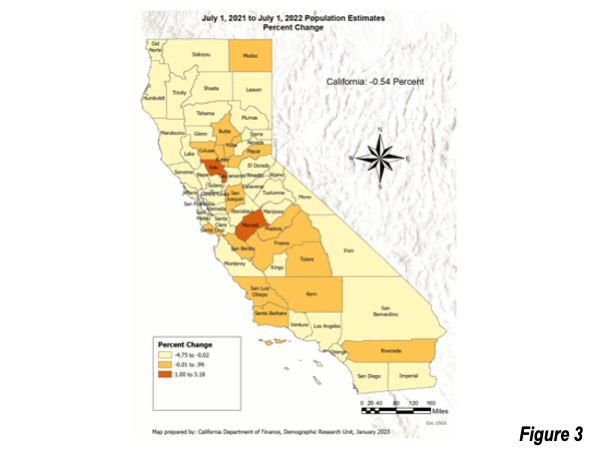
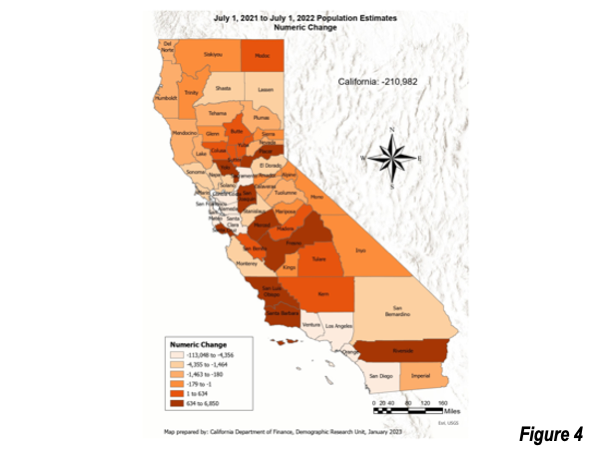
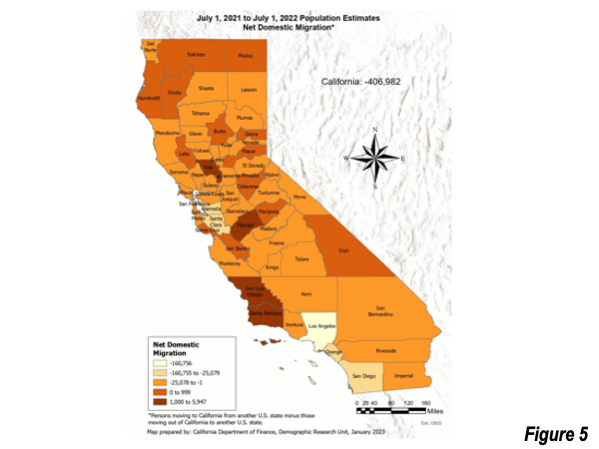
Yolo County edged out much larger Riverside County, which gained a 6700 residents, reaching a population of 2.44 million and has typically been among the fastest growing counties in the state. Riverside County sustained a net domestic migration loss, at 3,700.
Yolo County includes the city of West Sacramento, an extension of the Sacramento built-up urban area. A prominent University of California campuses is located in Davis and Woodland is the county seat.
Yolo County is well placed for commuting throughout the Sacramento metropolitan area. It is also well suited for hybrid model commuting (working mostly from home) to jobs located throughout the San Francisco and San Jose metropolitan areas. Yolo County and the Sacramento housing market (metropolitan area) also have considerably more affordable housing than the San Francisco and San Jose metropolitan areas, though it is still severely unaffordable by international standards. Sacramento’s median multiple (median house price divided by median household income) was 6.0 in the Fall, while much more affordable than San Francisco (10.7) and San Jose (11.5), where the median house had a price equivalent to from 4.7 to 5.5 more years of median household income. These factors auger well for the Yolo County in a state that has more than enough challenges in attracting residents from elsewhere.
Other Counties
Los Angeles County continued to be not only the largest county in the state, but also the nation, and is still nearly double the population of Cook County, Illinois (county seat: Chicago), which is the second largest in the nation (5.2 million). In 2022 Los Angeles County had 9.8 million residents, which is down more than 300,000 from its 2020 US peak of 10.1 million. Los Angeles County had the state’s largest loss, at 113,000, or a minus 1.14 percent rate. Los Angeles County lost 161,000 net domestic migrants, also by far the largest loss among the counties.
The second largest population loss was in Santa Clara County, heart of the Silicon Valley (county seat: San Jose). Santa Clara county lost 16,600 residents and now has a population of 1.83 million. Santa Clara county had the second largest net domestic migration loss, 30,900.
Alameda County (county seat: Oakland), across the Bay Bridge from San Francisco, had the fourth largest population loss at 16,000 or a rate of minus 0.96. Alameda County lost 27,300 net domestic migrants.
Orange County (county seat: Santa Ana), in the Los Angeles metropolitan area, had the fifth largest population loss, at 14,800, or a rate of minus 0.47 percent. Orange County also suffered the third largest net domestic migration lost, at 30,500.
Contra Costa County (county seat: Martinez), just north of Alameda County in the San Francisco metropolitan area lost 10,800 residents for a rate of minus 0.93%. Contra Costa County lost 16,400 net domestic migrants.
Sacramento County, adjacent to Yolo, lost 9700 residents, the rate of minus 0.61%. Sacramento County lost 18,800 net domestic migrants.
Ventura County, abutting Los Angeles County, lost 8900 residents, a loss rate of minus 1.06%. Ventura County lost 12,100 net domestic migrants.
San Mateo County (county seat: Redwood City), between Santa Clara county and San Francisco last 8100 residents, a rate of minus 1.08%. Its net domestic migration loss was 12,700.
San Diego County lost 4800 residents, but had a much higher net domestic migration loss, at 25,100, the second highest in the state.
San Francisco County (the city of San Francisco) had a loss of 4400 residents and 8700 domestic migrants.
The largest percentage losses, however, were in smaller counties. Lassen County (county seat: Susanville) had a 4.75 percent loss. Del Norte County (county seat Crescent City), where the Pacific Coast meets the Oregon border, had a 2.78 percent loss.
The table below summarizes the county data provided by the California State Department of Finance. The largest gains and losses in population and net domestic migration are illustrated in Figures 6 through 9.
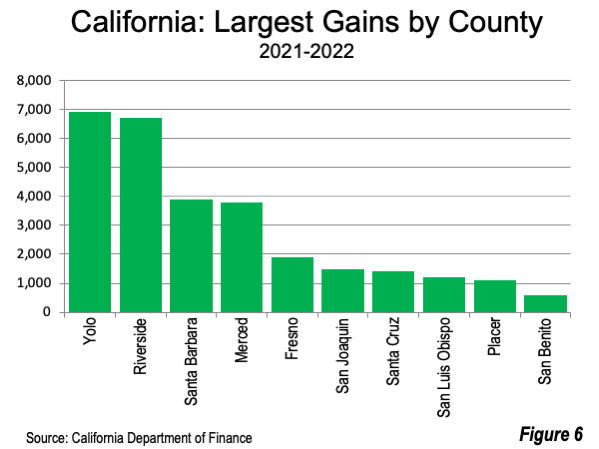
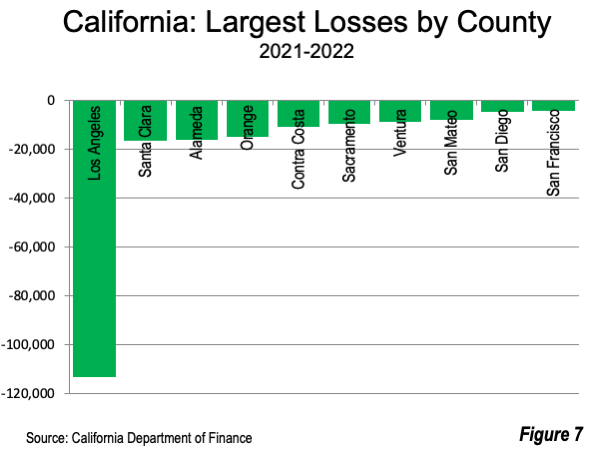
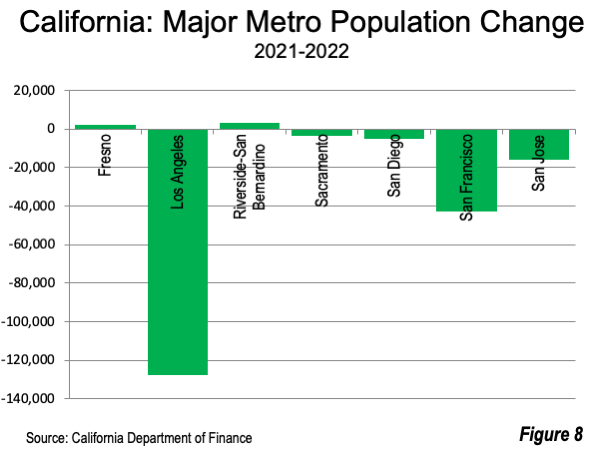
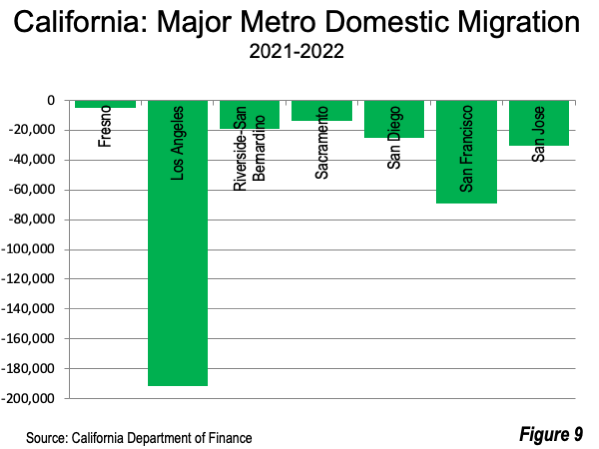
Major Metropolitan Areas
Population growth and net domestic migration for the major metropolitan areas (over 1,000,000 population) can be obtained by combining their county data). The Los Angeles, Riverside-San Bernardino, San Francisco, San Diego, Sacramento, San Jose and Fresno metropolitan areas had a disproportionately higher percentage of overall population loss compared to their share of the state’s population. These metros had 78.5% of the state population in 2021. They accounted for 90.3% of the population loss and 87.3% of the net domestic migration loss (Figures 4 and 5, above).
Perhaps the principal challenge in turning around the state’s demographics is materially improving housing affordability. According to the Sacramento Bee, H. D. Palmer, deputy director of external affairs at the California Department of Finance, said that the shrinking population reflects the Golden State’s housing affordability crisis.
It remains to be seen whether the rising concern in the state about this driver of domestic migration will be translated into results that do justice to the intentions.
Wendell Cox is principal of Demographia, an international public policy firm located in the St. Louis metropolitan area. He is a founding senior fellow at the Urban Reform Institute, Houston, a Senior Fellow with the Frontier Centre for Public Policy in Winnipeg and a member of the Advisory Board of the Center for Demographics and Policy at Chapman University in Orange, California. He has served as a visiting professor at the Conservatoire National des Arts et Metiers in Paris. His principal interests are economics, poverty alleviation, demographics, urban policy and transport. He is co-author of the annual Demographia International Housing Affordability Survey and author of Demographia World Urban Areas.
Mayor Tom Bradley appointed him to three terms on the Los Angeles County Transportation Commission (1977-1985) and Speaker of the House Newt Gingrich appointed him to the Amtrak Reform Council, to complete the unexpired term of New Jersey Governor Christine Todd Whitman (1999-2002). He is author of War on the Dream: How Anti-Sprawl Policy Threatens the Quality of Life and Toward More Prosperous Cities: A Framing Essay on Urban Areas, Transport, Planning and the Dimensions of Sustainability.
Photo: Yolo County, California’s 2022 growth center via Wikimedia in Public Domain.
Table (back to reference)
Click the image below to open a larger file in a new tab or window
